The cost of a numismatic Third-Party Grading Service like PCGS or NGC to certify your coin and grade is usually between $20 and $100 per coin, including shipping and insurance. The process usually takes between three weeks and two months. The cost varies depending on the service you request (speed, attribution, authentication only) and value of your coin.
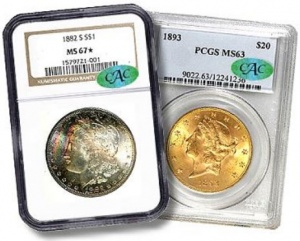
For more valuable coins like ultra-rarities, the certification cost can reach into the thousands of dollars. For faster service, like leaving your coin with the grading certification service at a coin show and picking it up before the show ends, the cost is higher.
If you’re unsure about whether or not your should get your coin certified, the Academy of Coins© has created an easy, quick, low-cost grading service alternative at PriceThatCoin.com.
PriceThatCoin.com is a much less expensive way to find out the value of your coin than traditional coin certification. And if you should certify your coin, we’ll tell you!
If you would prefer to understand the details of coin certification yourself, please continue reading…
The Major Third-Party Coin Certification Services
Third Party Grading services (TPGs) provide an incredibly valuable resource to the entire coin collecting community. As counterfeiters get better at faking coins, reputable TPGs are our only defense, certifying our coins as legitimate.
But if you believe your coin’s value may not be more than $100, it may not make sense for you to spend the time and money to have your coin authenticated, graded, and certified. An inexpensive expert opinion always helps in cases like this.
Why Are There Third Party Grading Services?
As coins became more valuable and commonly faked, the industry realized a need for arbitrators to protect both collectors and dealers.
It is human nature with coin collecting, as with all things, to see what you want to see rather than what’s there. And, as long as there have been coins (since around 600 BCE), there have been coin counterfeiters and doctors. Unscrupulous people have been profiting from coins, whether they be tax collectors, governments, or thieves, for thousands of years.
As the hobby of numismatics became an industry in the 1960s and 1970s, and people began to see coins as a real investment instrument in the 1980s, speculators took over the market. Prices began to spiral up and dealers began to disagree about grading standards. The difference between a grade point could mean the difference in value of thousands of dollars! The coin industry needed an accessible source of trusted, unbiased opinions, so that people could trade coins reliably and safely without seeing them in-hand. (This was before the Internet.)
Coin collecting welcomed Third-Party Grading as a solution. TPGs are companies comprised of extremely experienced numismatic professionals paid to render an unbiased opinion about a coin’s condition. They do not favor the buyer, nor the seller. Coin graders never know who submit the coins they grade. The TPGs go through quality and anonymity steps to ensure this is the case. Graders simply grade and authenticate coins without bias. The TPGs then stand behind their graders when they certify and encapsulate each graded coin.
Should I Get My Coin Graded and Certified?
If you are sure that your coin is worth more than $100, you should probably send your coin to a major third-party coin grading service like PCGS or NGC for grading and certification. If you believe your coin is worth more than $1000, you almost always should get your coin certified. This is especially true if you have the $100 to $200 available to invest in protecting your coins. Once you have your coins certified, you know what you have.
Doing this properly can be costly and time consuming. But doing it improperly is a complete waste of money. It can be frustrating if it turns out your coin is only worth $20. Or, you could find out your coin is a counterfeit (worth nothing), or that it’s nothing more than spending change! The major certification services get coins like these all the time.
Before you invest the time and effort in shipping your coins in for certification, it’s usually best to find a friendly source outside the TPGs for low-cost advice. You can take your coins to a local coin dealer (if there is a reputable one nearby). Another option is to take them to a local coin show to seek advice. Coin shows are events with many dealers in the same venue, and they’re a great place to learn about coins. If you want to maximize your sale or learn more about coins, it’s a worthwhile venture.
Okay, I Definitely Want to Get My Coins Graded and Certified. How Do I Get My Coins Certified? Where Do I Go?
Option #1: If you have a major coin show that regularly comes where you live, you may be able to get your coins graded and certified at the show.
Option #2: If you have a local coin dealer that you feel is trustworthy, you can sometimes take your coins to the dealer for a “piggyback” submission. Reputable coin dealers submit hundreds or thousands of coins per year to PCGS and/or NGC for certification. It might cost you a bit less to have them add your coins to their next submission. But, it’s up to the coin dealer if they’ll do this service for you or not. It is definitely a favor. Some dealers feel more comfortable charging a small fee on top of the TPG’s grading fees. Look for PNG Dealers, or PCGS Authorized dealers for PCGS submissions and NGC dealers for submissions to NGC.
Option #3: Submit your coins for grading and certification yourself. Unless you take them to a show, you must almost always ship the coins to the TPG, and have them ship your coins back to you. You will likely need to insure the coins for the shipment there and back. This adds time and cost to the process.
Often, the submission forms and procedures are confusing to people that haven’t yet gone through the certification process. The major TPGs have excellent Customer Service departments that are happy to help.
You have to understand, these services are in extreme demand for many reasons. So you just have to grin and bear difficulties.
Does Getting A Coin Certified Make It More Valuable?
Getting your coin certified will almost always make it more liquid on the market. The reason is consumer confidence. Collectors and dealers know that when a reputable TPG like PCGS or NGC certifies a coin, an expert looked at the coin carefully and described the coin’s condition accurately. Transactions for certified numismatic coins are much easier for both buyer and seller.
The exception to this rule is common 1-ounce silver bullion like uncirculated or proof American Silver Eagles. If you want certified bullion, carefully buy your coins already certified (slabbed) at a price close to the bullion cost. If you’re assembling a set, of course buy in the grade you prefer. But if you intend to sell your coin at some point to a silver coin dealer, it almost never makes sense to spend the time and money to certify your bullion coins. If you’re concerned about your coin’s authenticity, certification is the best way to have it verified. Even when the coins receive a full 70/70-point grade, most dealers won’t pay any more for them, unless they are a key date. When the market or collector treats a bullion coin as numismatic, grading and certifying is certainly an option.
However, there are many fakes of gold, platinum, and numismatic world silver coins. These coins, which tend to have a value of over $1000, should likely be graded and certified.
The Major Coin TPGs Today

Professional Coin Grading Service
PCGS is the clear coin certification leader today in vintage U.S. coins. The cost to submit with return shipping and insurance ranges from at least $20 to thousands of dollars. Most collectors who submit coins requesting standard service pay on average between $50 and $100 per coin for certification. Their turnaround times vary greatly. It is possible to get PCGS to certify and slab your coins in a few days for extremely expensive services, for high-valued coins handled at coin shows. But for the average collector, the time required including shipping is a month or two. PCGS grades thousands of coins per day, so they usually have a significant backlog.
Crucially, PCGS also guarantees the value of the coins they grade and certify. If they certify a coin and are somehow wrong, they pay the market price (based on their price guide) for the coin. They charge a 1% fee for this guarantee of valuable coins.
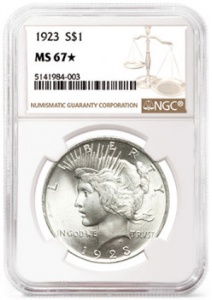
Numismatic Guaranty Corporation
NGC has been around slightly longer than PCGS, and they’re a strong number two. Collectors trust NGC above all other TPGs for opinions about ancient coins. PCGS has certified world coins for some time, but many collectors still prefer NGC. As NGC has decades of experience and the only usable online price guide for non-U.S. coins, NGC is still seen as the go-to for world coins. Like PCGS, they also do a strong modern coin business, creating new gimmicky labels for modern bullion and commemorative coins. NGC certification costs less than PCGS, but their coins are typically not quite as liquid. Their service price per coin range from about $18 (including shipping) up to thousands for substantially valuable coins. Their turnaround times are typically less than PCGS – between a few days for show submissions to a few weeks for standard submissions. Normally, they won’t take longer than a month, but there is no guarantee. NGC coins usually do not demand quite as much on the open market as PCGS coins. For the most part we’re talking small percentage points. Before sending your coins for grading and certification, you might want to see which service grades which coins more harshly, and which coins are worth more to the market in which slabs.

Certified Acceptance Corporation
CAC is a relatively new player to the scene, but the impact they’ve had on the coin market (especially certain parts) is drastic. CAC puts a green sticker (a “green bean”, we call it) on PCGS- or NGC-certified coins submitted to them if they feel the coin is premium quality for the grade. They put a gold sticker on every coin submitted to them if they feel it is under-graded. If they feel the coin is not excellent for the grade, they will not put their sticker on it. The value of Green CAC coins is everything from a few percent more than like, non-stickered coins, to substantially more (sometimes nearly double).
The average collector can’t submit their coins to CAC. Not even all dealers can. The cost is nominal, but being allowed to submit is the substantial barrier to entry.
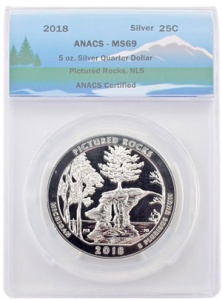
American Numismatics Association Certification Service
ANACS is the US’ oldest grading and certification service, originally a service of the American Numismatics Association (ANA). The certification service ANACS was broken off and sold to private hands many years ago. This is a good thing because politics have plagued the ANA for a long time. This is a bad thing because it’s confusing to consumers.
Some scuttlebutt and inconsistent grading have hurt ANACS’ reputation in recent times. However, as always, they’re making a substantial effort to fix their reputation. Their costs are lower and turnaround times are shorter than PCGS. Their costs and return times are about on par with NGC, but their holder’s premium is also less across the board. This may change over time as they successfully repair their reputation.
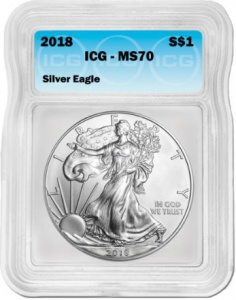
Independent Coin Graders
ICG is a quality player in the game, but they’re small and they don’t have the reputation of the others. Their costs and turnarounds are about the same as ANACS and NGC. They charge possibly under $20 per coin including shipping, and may only require a couple of weeks. As they don’t have the name brand reputation of NGC or PCGS, coins in their holders usually don’t bring as much at auction. As they become more mainstream, this is changing. But for now, they’re simply not as widely as accepted as PCGS or NGC.
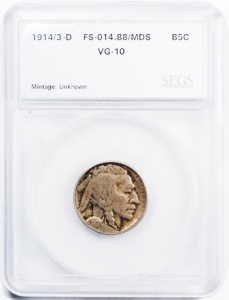
Sovereign Entities Grading Service (not to be confused with SGS)
SEGS is another a quality player. They lack the reputation of the big dogs. Like ICG and ANACS, the per coin cost might be under $20 including shipping. Most collectors still prefer NGC and PCGS.
Other Grading Services
There are many other grading certification services that are scammers. Proceed with caution. If you’re buying, carefully buy the coin, not the holder. If you’re selling, don’t bother with them.
You might find that collectors and dealers alike constantly complain about the quality of work done by the TPGs. This is because the dealers and collectors for TPGs into the position of being in the bad news business. Sometimes dealers and collectors think they know better than the TPGs. On the whole, it’s simply that dealers and collectors don’t like finding our they were wrong. (The TPGs do make a mistake once in a while – they’re only human.)
For the average collector, or for the person interested in collecting, all of this is extremely complicated and difficult to understand. Most new people just want to know more about their coins. The TPGs provide an incredibly valuable service for the entire industry.
Interpreting the Slab
If you have a coin graded, certified, encapsulated by PCGS, NGC, ANACS, ICG, or SEGS, you can learn a great deal about the coin from the holder. The label has the type, the year, the mint that made it, and an approximate grade. (Depending on how much you trust the graders, you may interpret this as an exact grade.) From there, you can find a market value estimation. Sometimes coins have variety information, sometimes they do not. There are many online resources where you can use this information to get an idea of market price. If nothing else, you can check auction houses for recently sold comparables. (Do not use asking prices; use recently-sold examples’ sale prices.)
Continue learning what makes a coin valuable:
Next: Bullion versus Numismatic Value of Coins
Previous: Basic Visual Coin Pricing Guide
Interested in collecting coins? Here are some coins we found that appear to be a good deal. They are priced well compared to the current price guides. We do not buy nor sell coins, we just thought you might be interested in learning more about the market.
